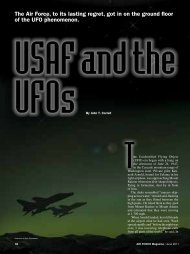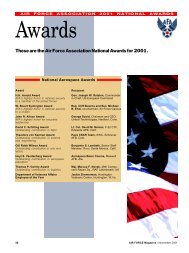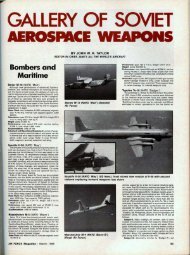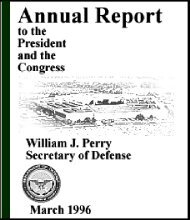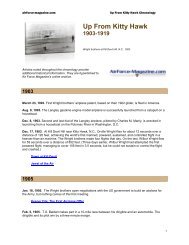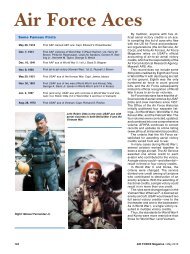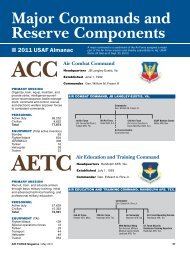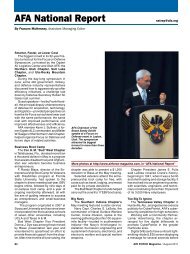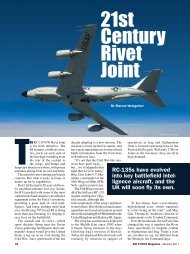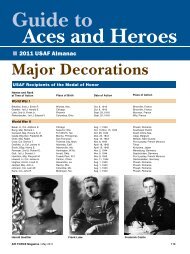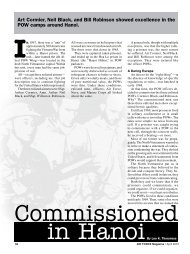1997 Annual Defense Report Table of Contents - Air Force Magazine
1997 Annual Defense Report Table of Contents - Air Force Magazine
1997 Annual Defense Report Table of Contents - Air Force Magazine
Create successful ePaper yourself
Turn your PDF publications into a flip-book with our unique Google optimized e-Paper software.
level. By looking at recurring SORTS data, decision makers can determine whether sufficient assets are<br />
allocated to personnel, equipment, supplies, or training.<br />
To enhance the ability <strong>of</strong> SORTS to provide accurate data on current readiness, the Department has<br />
undertaken a SORTS reform and enhancement process. Many parts <strong>of</strong> the SORTS system are antiquated.<br />
A recent report by the DoD Inspector General stated, "Decision makers cannot rely on SORTS data for<br />
decisions because <strong>of</strong> problems related to accuracy, timeliness, and relevancy." The Department is<br />
currently evaluating changes to SORTS that would remedy known shortcomings and make readiness data<br />
available in a much more timely fashion. DoD is also evaluating ways to make the system more flexible,<br />
more responsive, more reliable, and easier to use. In addition to providing improved information for<br />
decision makers, upgrading the quality <strong>of</strong> data improves the Department's ability to respond accurately to<br />
public concerns about readiness.<br />
Joint Mission Essential Task Lists as Performance Standards<br />
The basic building block <strong>of</strong> unit readiness is the ability to perform the specific tasks and missions<br />
required in a wartime scenario. To evaluate the readiness <strong>of</strong> individual units, the Department must<br />
consider what the units need to be ready to do in a wartime environment. To measure an organization's<br />
ability to perform specific joint tasks, the CINCs have developed Joint Mission Essential Task Lists for<br />
all missions.<br />
By the end <strong>of</strong> FY 1998, the Services will link the Component Command Mission Essential Task Lists<br />
(METLs) with the Joint Training System-approved JMETLs, and incorporate the JMETLs as the source<br />
for guiding Service unit training. Integrating JMETLs into the readiness assessment process will give<br />
decision makers standards <strong>of</strong> performance against which individual unit capability can be measured.<br />
This project does not change the missions that the CINCs are expected to perform. Instead, it specifies the<br />
tasks in sufficient level <strong>of</strong> detail to allow staffs and units to train and fully develop the necessary level <strong>of</strong><br />
both unit and joint readiness. This ongoing process focuses on train-like-you-fight activities and will<br />
enhance joint training and exercises. It will eventually provide a basis to measure readiness in terms <strong>of</strong><br />
output (readiness to accomplish the specified mission) rather than today's input-oriented (readiness to<br />
perform as intended by the unit design) processes.<br />
Measure and Balance the Deployment Load on Military Personnel<br />
One cannot understand readiness without the ability to assess the capability <strong>of</strong> military personnel to<br />
perform. As participation in contingency operations becomes standard, units and personnel are<br />
increasingly deployed for extended periods on a recurring basis. These deployments have numerous<br />
effects on readiness. For example, because units deployed to contingency or humanitarian operations do<br />
not always use wartime skills, combat training may be degraded. Extended deployments adversely affect<br />
morale and quality <strong>of</strong> life for the deployed personnel. This can affect both mission performance and<br />
retention rates.<br />
The Department has undertaken several initiatives to monitor and assess the effects <strong>of</strong> personnel<br />
deployments. First, under the auspices <strong>of</strong> the SROC, the Joint Staff Manpower and Personnel Directorate<br />
(J-1) conducted a study <strong>of</strong> the levels <strong>of</strong> Personnel Tempo (PERSTEMPO) and determined which units<br />
and skills were reaching levels at which readiness would be affected. Results <strong>of</strong> this study allowed the<br />
military Services to take action in their programs to <strong>of</strong>fset excessive PERSTEMPO.<br />
33


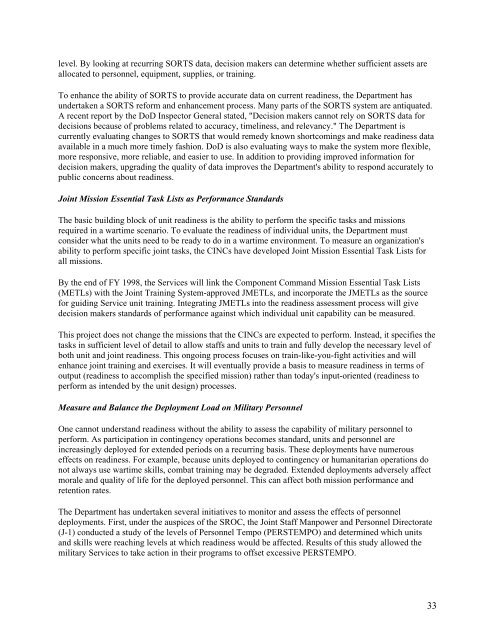
![[PDF] Foulois - Air Force Magazine](https://img.yumpu.com/13391007/1/190x253/pdf-foulois-air-force-magazine.jpg?quality=85)
